Imagine you're a participant in a game show and you get asked the following question: "Which ships use the first seven notes of a song's melody as their horn signals?"
The answer, of course, would be the ships of the Disney Cruise Line. The song in question? "When You Wish Upon A Star" (which won the 1940 Academy Award for Best Original Song). Written by Leigh Harline and Ned Washington for Walt Disney's 1940 release of Pinocchio, the song's familiar lyric advises children of all ages that:
"When you wish upon a star, makes no difference who you are
Anything your heart desires will come to you.
If your heart is in your dream, no request is too extreme
When you wish upon a star as dreamers do."
Wishes form the foundation of fairy tales, romantic films, and idle fantasy. There are times, however, when one's innocent fantasies can go horribly wrong and what started out on such a promising note can evolve into a horrifying nightmare. Consider the following example:

* * * * * * * * * *
Late in 1986, while attending some performances at the San Diego Opera, I visited the Old Globe Theatre to attend two preview performances of a new musical by Stephen Sondheim and James Lapine. From its very first moments, Into The Woods struck me as the perfect challenge for a composer who loves puzzles.
The new musical (which opened on Broadway the following spring) took some of literature's favorite characters from fairy tales (Cinderella, Prince Charming, Rapunzel, Little Red Riding Hood) and contrasted their initial status (when they were actively wishing for a change in their lives) to what happened after their wishes had been granted and they supposedly lived "happily ever after."
In the 27 years since I first experienced Into The Woods, the show has achieved phenomenal success. The original Broadway production ran for 765 performances. A taped performance with most of the original cast was broadcast by PBS on March 20, 1991 and, in 2002, a Broadway revival starring Vanessa Williams ran for 279 performances.
In recent years, some theatre companies have taken new approaches to staging the show. In 2010, the Regent's Park Open Air Theatre in London recast the Narrator as a young school boy (instead of an old man) who had become lost in the woods during a family argument. That production (available for download at www.digitaltheatre.com) was bought to the Delacorte Theatre in Central Park during the summer of 2012, where it received far less than rapturous reviews.
The Fiasco Theater's recent production (staged at the McCarter Theatre in Princeton, New Jersey) was hailed for its imaginative approach to the musical.
Directed by Rob Marshall (Nine, Chicago), a film adaptation of Into The Woods is scheduled to begin shooting this fall with Meryl Streep as the Witch, Johnny Depp as the Wolf, James Corden as the Baker, Emily Blunt as the Baker's Wife, Anna Kendrick as Cinderella, Christine Baranski as Cinderella's wicked stepmother, and Tracy Ullman as Jack's mother, .
When I first saw Into The Woods in a 600-seat theatre in San Diego, I remember being stunned by the show's intricacy and Sondheim's phenomenal through composition of the lengthy prologue and title song. What the above clips clearly demonstrate is that Into The Woods offers theatre companies of all sizes exceptional opportunities for creative costuming, set design, and perhaps even a little bit of re-interpretation without altering the text of what has become a cherished piece of great theatre art.
Here in San Francisco, Ray of Light Theatre recently staged Into The Woods in the 200-seat Eureka Theatre with only one major alteration: Instead of having one man portray the Narrator, the Old Man, and the Wolf, the role of the Wolf had been assigned to another artist.
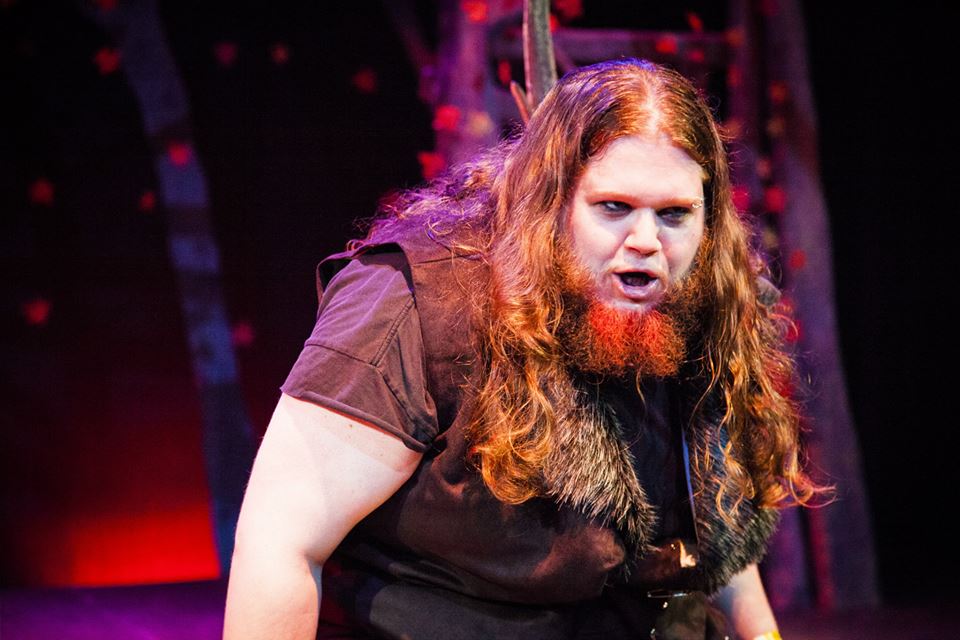
John Flaw Harrison as The Wolf (Photo by: Erik Scanlon)
Otherwise, Eliza Leoni's production was pretty much by the book. With sets by Annie Dauber, costumes by Miriam Lewis, sound design by Anton Hedman, and musical direction by David Moschler, what made Ray of Light's production so appealing was the chance to hear Sondheim's lyrics performed in such an intimate space where no one was wearing a body mike.
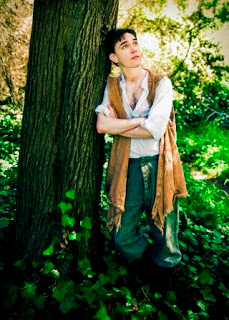
Kyle Stoner as Jack (Photo by: Erik Scanlon)
Although the role of the Witch is often cast with an eye toward the box office, Into The Woods has never really been a star vehicle. Minus the pressure to have a major personality or celebrity in that role, Ray of Light's production stressed ensemble work, with winning performances coming from Courtney Merrell as Cinderella, Kyle Stoner as Jack, Austin Ferris as the Baker, and Marisa Cozart as the Baker's Wife.

Allison Meneley as Little Red Riding Hood (Photo by: Erik Scanlon)
Scene stealers included Allison Meneley as Little Red Riding Hood, John Flaw Harrison as the Wolf, Ted Zoldan as Rapunzel's Prince, Nikki Arias as Cinderella's Stepmother, and Melissa Reinertson as Rapunzel. While Michelle Jasso's portrayal of the Witch was appropriately sensual, I'm sure I'm not the only one in the audience who was drawn to David Naughton's physical and comedic charms as Cinderella's Prince.
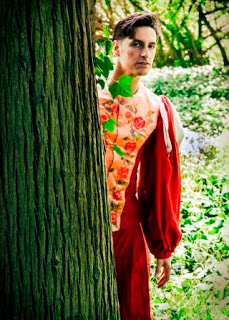
David Naughton as Cinderella's Prince (Photo by: Erik Scanlon)
Ray of Light is one of the Bay area's community theatre groups (Broadway by the Bay, Lamplighters Music Theatre, Woodminster Summer Musicals) that specializes in musicals and light opera. What always impresses me about their work is the high level of musical preparation and solid diction (their 2010 production of Jerry Springer: The Opera was quite remarkable).
On October 4, Ray of Light Theatre will present the West Coast premiere of Carrie: The Musical at the Victoria Theatre. Prepare for a bloody good night of musical theatre!

Christina Ann Oeschger as Carrie (Photo by: Erik Scanlon)
* * * * * * * * * *
The California Shakespeare Theater opened its 2013 season with a rabble-rousing production of American Night: The Ballad of Juan José. Written by one of Culture Clash's co-founders (Richard Montoya) and directed by Jonathan Moscone, this one-act play is essentially a comic nightmare showcasing the challenges faced by a Mexican man hoping to find a better life for himself and his family in the United States.
Because of its slick production values, it's easy to mistake American Night for a well-funded production that sprang from the collective consciousness of the San Francisco Mime Troupe. Having just read Tony Horwitz's amazing piece in The Atlantic ("The Mammy Washington Almost Had"), there was little in Montoya's rowdy political satire that could shock me.
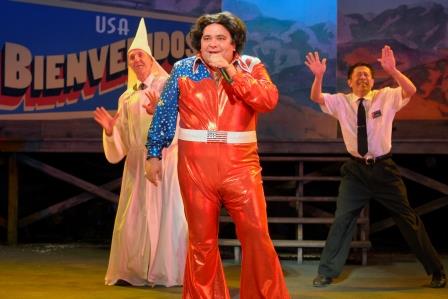
Dan Hiatt as a Klansman, Richard Ruiz as Neil Diamond,
and Todd Nakagawa as a Mormon in a scene from
American Night: The Ballad of Juan José
(Photo by: Kevin Berne)
The talented Sean San José stars as Juan José, an idealistic Mexican immigrant studying for his American citizenship test. Whether receiving guidance and emotional support from two Mormons (Dan Hiatt and Todd Nakagawa) or traveling the highways and byways of American folklore, American Night introduces its protagonist to the real and imaginary heroes of American history.
Montoya's script takes aim at some of the more controversial forces in contemporary American culture (the Mormon church, the Ku Klux Klan, the Tea Party) while using cultural icons such as Sacagawea, Lewis & Clark, Teddy Roosevelt, Jackie Robinson, and Sheriff Joe Arpaio as comedic foils.
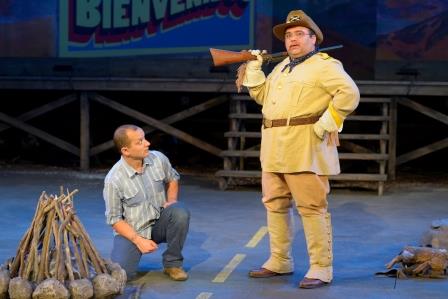
Juan José (Sean San José) meets Teddy Roosevelt (Richard Ruiz)
in a scene from American Night: The Ballad of Juan José
(Photo by: Kevin Berne)
Along the way, Juan José also learns about some important yet often unheralded Americans who became folk heroes. People such as:
- Viola Pettus (an African American nurse in Marathon, Texas who was willing to treat anyone who needed medical help during the 1918 flu pandemic).
- Labor leader Harry Bridges, the co-founder of the International Longshore and Warehouse Union who was a crucial figure in 1934's 83-day-long West Coast Waterfront Strike.
- Ralph Lazo, a native of East Los Angeles whose lineage was part Mexican-American and part Irish-American. When he turned 18, Lazo traveled to Manzanar to join his high school friends who had been rounded up and sent to a Japanese-American internment camp.
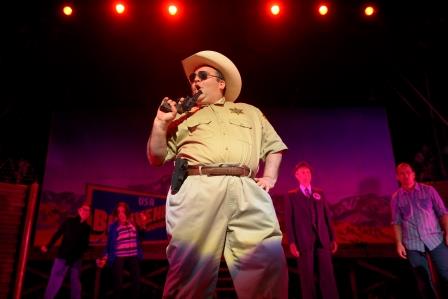
Richard Ruiz as Sheriff Joe Arpaio (Photo by: Kevin Berne)
The fact that Richard Ruiz (the cast member portraying Sheriff Arpaio, President Teddy Roosevelt, and Neil Diamond) bore a striking resemblance to Supreme Court Justice Antonin Scalia only served to underline Montoya's message that "Sure, America sucks, but it swallows." As director Jonathan Moscone stressed in his program note:
"Being unsafe is sometimes the best place to be in the theater. It makes us alive with authentic feeling and thinking, laughing our way into a new consciousness, and seeing things with clear and compassionate eyes. This play doesn't make it easy on anyone -- artist or audience. The questions surrounding who belongs in America are profound and contradictory, and Richard shies away from none of the complexities in Juan José's story. No place feels safe in this American Night -- not the United States, not Mexico, not anywhere in Juan José's fevered brain as he journeys across the borders of his past and the past of our country in search of a new identity.
Montoya writes like a musician -- a jazz musician to be specific. He riffs, he shifts direction, he tells his way through a scene, whether it's a one-page, Benny Hill-inspired vaudeville (witness the Nike maquiladoras sequence) or his longest scene, a mini-play in which the unknown story of Viola Pettus, nurse during the 1918 Spanish Flu epidemic in West Texas, is told through a mix of dark humor, political tension, and unexpected grace."
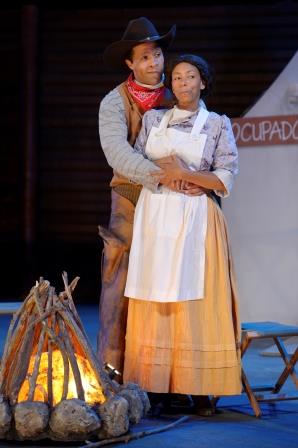
Tyee Tilghmann and Margo Hall as Ben and Viola Pettus in
American Night: The Ballad of Juan José
(Photo by: Kevin Berne)
Working on Erik Flatmo's unit set (with sound designed by Cliff Caruthers and costumes by Martin Schnellinger), Moscone had a tried and true ensemble of familiar faces onstage jumping in and out of one role after another. From CalShakes veterans Margo Hall, Dan Hiatt, Sharon Lockwood, Brian Rivera, and Tyee Tilghman to debuting artists Dena Martinez, Todd Nakagawa, Richard Ruiz and Sean San José, the entire company worked hard to sell Montoya's script to the audience. To say they succeeded would be a severe understatement.
To read more of George Heymont go to My Cultural Landscape
